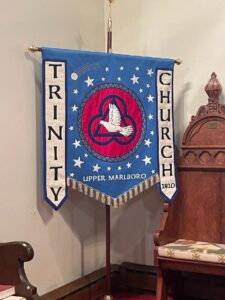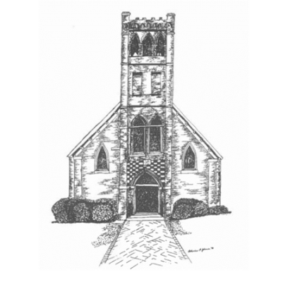 In the late 18th century, Colonel Ninian Beall, an indentured servant from Scotland who became a member of the Maryland House of Burgess, donated the property now designated as 14515 Church Street, Upper Marlboro for a Presbyterian church. A wooden meeting house was built on the property. Almost 20 years later, the wooden Presbyterian meeting house was taken over by Trinity Protestant Episcopal Church in Upper Marlborough. A vestry was elected and Dr. William Beanes was the first Senior Warden. David Crauford, III deeded the property to Trinity. On July 16, 1812, Episcopal Bishop Thomas John Claggett consecrated Trinity Church. Bishop Claggett was both the first Chaplain of the U.S. Senate in the new federal city and the first American Episcopal Bishop consecrated on American soil.
In the late 18th century, Colonel Ninian Beall, an indentured servant from Scotland who became a member of the Maryland House of Burgess, donated the property now designated as 14515 Church Street, Upper Marlboro for a Presbyterian church. A wooden meeting house was built on the property. Almost 20 years later, the wooden Presbyterian meeting house was taken over by Trinity Protestant Episcopal Church in Upper Marlborough. A vestry was elected and Dr. William Beanes was the first Senior Warden. David Crauford, III deeded the property to Trinity. On July 16, 1812, Episcopal Bishop Thomas John Claggett consecrated Trinity Church. Bishop Claggett was both the first Chaplain of the U.S. Senate in the new federal city and the first American Episcopal Bishop consecrated on American soil.
 The present brick church building was consecrated on December 31, 1846 and, in 1885, Trinity Cemetery on Rectory Lane was established. The church was renovated and the bell tower was added to the front in 1886, the 50th anniversary of the consecration of Trinity.
The present brick church building was consecrated on December 31, 1846 and, in 1885, Trinity Cemetery on Rectory Lane was established. The church was renovated and the bell tower was added to the front in 1886, the 50th anniversary of the consecration of Trinity.
In modern times, Trinity Episcopal Church purchased and restored a 1909 Tracker pipe organ in 1980 and completed a massive restoration in 1987. The Rt. Rev. John T. Walker, first Black Bishop of the Washington Diocese, rededicated Trinity Church. The parish’s bicentennial was celebrated in 2010 with the debut of the play Trinity Episcopal Church and the Dawning of the National Anthem by Tricia Politte. In 2022, Trinity became a Mission of the Episcopal Diocese of Washington. The Reverend Dr. Peter M. Antoci was called as Mission Vicar.
Learn more about Trinity’s history by reading Celebrating 200 Years of Faith. This book is available by contacting Trinity Episcopal Mission.
 Trinity and The Star-Spangled Banner
Trinity and The Star-Spangled Banner
During the War of 1812, British troops billeted in Trinity Church on their way to burn Washington, D.C. They stabled their horses in the old frame structure and kneaded bread on the tombstones in the churchyard. In September 1814, Trinity’s Senior Warden Dr. William Beanes placed some rowdy British troops in the local jail. British General Ross had Dr. Beanes arrested, charged with treason and put aboard a ship in the Baltimore Harbor. President James Madison appointed a young Georgetown lawyer, Francis Scott Key, to go and negotiate for Dr. Beanes’ release. On September 13, while Key was aboard a neutral ship in the harbor, the massive British bombardment of Baltimore’s Fort McHenry began. Following the 25-hour attack, Key saw the huge, impressive U. S. flag through the smoke. He was inspired to write the poem “The Star-Spangled Banner” – which was eventually designated the national anthem. There is a The Star-Spangled Banner National Historic Trail marker at Trinity.


